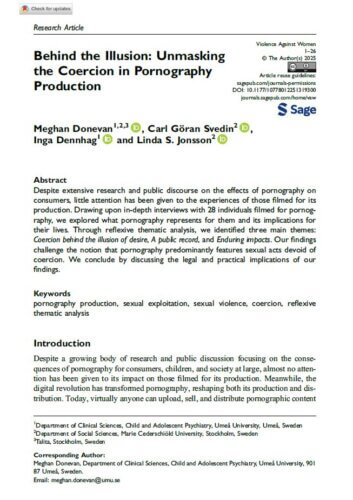Mental Health
Behind the Illusion: Unmasking the Coercion in Pornography Production.
Open Access: No.
Abstract
Despite extensive research and public discourse on the effects of pornography on consumers, little attention has been given to the experiences of those filmed for its production. Drawing upon in-depth interviews with 28 individuals filmed for pornography, we explored what pornography represents for them and its implications for their lives. Through reflexive thematic analysis, we identified three main themes: Coercion behind the illusion of desire, A public record, and Enduring impacts. Our findings challenge the notion that pornography predominantly features sexual acts devoid of coercion. We conclude by discussing the legal and practical implications of our findings..
Relevance
“Nearly all participants had experiences being filmed or photographed for pornography under direct duress. The abuse was perpetrated by a range of male perpetrators, including fathers, stepfathers, other male relatives, intimate partners, and traffickers. Typically, the first instance of filmed abuse was perpetrated during the participants’ childhood, or otherwise early adulthood… appearing in pornography represented not just one instance of filmed abuse but the documentation and dissemination of long-term, systematic exploitation.”
For many performers, “compliance is a façade maintained under duress and the threat of further harm, functioning as a survival strategy to avoid additional violence.” This coercion included performing sex acts that were demanded by those who paid, including the viewers of sex webcamming.
The performers often feared that the public would see their pornographic videos – despite the fact that the videos actually documented crimes and violence that included rape, sexual abuse, and trafficking – as consensual rather than coerced and forced. They also experienced victim-blaming.
Additionally, performers suffer “the invasive reach of male buyers and consumers” who feel that they have a “perpetual” entitlement over pornographic performers, especially women. This “creates a serious threat to personal safety.” They also feel ‘trapped’ by the permanence of pornography once it is put online, making it extremely difficult to fully exit the industry.
“The long-term impact of pornography on participants’ daily lives manifested in a range of severe health challenges, including substance abuse, multiple diagnoses such as PTSD, the need for medications, chronic health conditions, nonfatal self-injury, suicidal ideation, and suicide attempts.”
“In grappling with the dissonance between compelled behaviors and true feelings, as well as exposure to multiple forms of violence, participants developed necessary coping mechanisms and forms of resistance.” Common strategies for coping include drug and alcohol abuse (“to numb participants from the sexual acts”); dividing or fragmenting the self into two identities, one authentic, the other tailored to buyers; and psychological dissociation (“disconnecting from the present moment”), which has long-term consequences, including “dissociative seizures.”
Citation
Donevan, M., Svedin, C. G., Dennhag, I., & Jonsson, L. S. (2025). Behind the Illusion: Unmasking the Coercion in Pornography Production. Violence Against Women. https://doi.org/10.1177/10778012251319300

